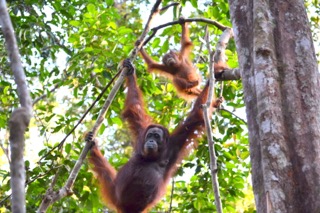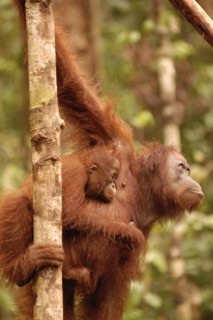- Male orangutans that resettle to a new area appear to be imitating the behavior of a local individual in an effort to survive and find a future home range, a new study says.
- The researchers have dubbed the behavior learning skill as “peering” and describe it as when migrant male orangutans intensively observe over a period of time a certain local they have chosen as a role model.
- The scientists analyzed data of hundreds of Sumatran and Bornean orangutans in research stations in Aceh and Central Kalimantan.
- Indonesia is home to the world’s three orangutan species: Sumatran, Tapanuli (P. tapanuliensis) and Bornean orangutans.
JAKARTA — Male orangutans that resettle to a new area appear to be imitating the behavior of local individuals in an effort to survive and find a future home range, a new study says.
Male orangutans that have reached sexual maturity tend to leave their birthplace and migrate to find a new home where they will adopt different skills of foraging, a group of researchers from universities in Germany, France and Indonesia reported in their recently published paper in the journal Frontiers in Ecology and Evolution. They’ve dubbed the behavior learning skill as “peering” and described it as when migrant male orangutans intensively observe over a period of time a certain local they have chosen as a role model.
“Over the last few years, we have gained a pretty good understanding of observational social learning in immature orangutans and other primates so far,” Julia Mörchen, a Ph.D. candidate at the Max Planck Institute of Animal Behavior in Konstanz, Germany, who is the lead author of the paper, told Mongabay in an email interview. “However, natural learning in adult primates in the wild remains largely uninvestigated.”
 Photo taken by Dr. Gary Shapiro
Photo taken by Dr. Gary Shapiro
“Our results provide evidence that in general adult male orangutans are able to learn and ‘update’ their already learned knowledge repertoires, when they are confronted with a new and unknown ecology,” she said.
Previous research showed that adult male orangutans disperse to find a new habitat while females tend to remain near their mothers’ home range. Mörchen said her team’s study was part of a bigger project where they wanted to understand how observational social learning helped migrating orangutan males to adapt to new areas after their dispersal. She added that they wanted to find out whether or not local orangutans learned something in return.
“We are interested to understand how cultural knowledge exchange between migrants and locals happen, and which factors might facilitate relaxed learning situations,” Mörchen said.
The researchers analyzed 4,009 daily associations between two individuals with and without peering events of 77 males of the highly sociable Sumatran orangutans (Pongo abelii) at the Suaq Balimbing Research Station, South Aceh, Sumatra, and 75 males of the less sociable Bornean orangutans (P. pygmaeus) at the Tuanan Research Station in Central Kalimantan. The data for the research were collected from 2003-18 and 2007-20 covering a combined study time of 30 years.
Indonesia is home to the world’s three orangutan species: Sumatran, Tapanuli (P. tapanuliensis) and Bornean orangutans. The Sumatran and Tapanuli orangutans are found nowhere else on Earth, while the Bornean orangutan also occurs in Malaysia and possibly Brunei, which share the island of Borneo with Indonesia. Habitat loss, fires, poaching and human-wildlife conflict are the main factors that have generally driven these species to the brink of extinction in the wild.
They found that peering rates among migrant orangutans were highest shortly after their arrival and significantly decreased with more time spent in the area. These orangutans were found to focus more on observing food items that were rarely eaten within the locals’ diet than at commonly eaten ones, and peering significantly more at skill-intense food items than easy-to-process ones. They added that the orangutans would interact more with those food items after the peering event than before, suggesting that they practice the acquired behavior.
Mörchen noted that orangutans were highly dependent on social learning and were known to exhibit diverse and complex cultural repertoires. Since these migrant males likely originate from different geographic areas, they also might be possessing different cultural knowledge than the local individuals, she added.
“Finally, by comparing orangutan males from two different species, that are known to differ in their evolved levels of sociability due to differences in habitat productivity, we also want to shed light on how differences in social learning opportunities might affect social learning propensity in general,” she said.
 Photo taken by Dr. Gary Shapiro
Photo taken by Dr. Gary Shapiro
Behavioral research on wild orangutans, like the latest paper, is important and beneficial to support and improve ex-situ conservation efforts, said Julius Paolo Siregar, head manager of the wildlife NGO Yayasan Ekosistem Lestari, which runs orangutan rehabilitation and relocation projects in Indonesia.
Julius, who was not involved in the study, said peering could be a great option to implement when dealing with younger orangutans that have been rescued and potentially could be relocated to a new home. “It could be better than having [human] keepers teach them,” he told Mongabay in a recent phone interview after reviewing the paper on our request.
“In the world of conservation, we need to also learn about the behavior of wildlife,” he said. “Not many may know that orangutans that learn from other orangutans have a bigger chance to survive in the wild than those that are taught by keepers. We need long-term research like this.”
 Photo taken by Dr. Gary Shapiro
Photo taken by Dr. Gary Shapiro
Mörchen said, acknowledging such incredible social learning ability in adult individuals, that the lessons for conservation that could be taken from their study would therefore be to make sure that when individuals will be housed together or will be translocated to new places, these situations will allow social learning between individuals by ensuring competition over resources is low.
She added that it would also mean not to relocate individuals in already inhabited forests, where studies have found that especially local females react sensitively to increased levels of competition from an influx of newcomers, and they will decrease their low level of gregariousness and social tolerance even more. Finally, whenever possible, family ties between individuals should be taken into account, and individuals that are related to each other, or have developed a beneficial social relationship with each other, should favorably stay together, she said.
“Research on threatened wildlife, like orangutans, plays a crucial role in helping towards their conservation,” Mörchen said.
Mörchen said many questions related to male orangutans’ dispersal patterns and how they navigate this phase remain unanswered, such as regarding their geographic and cultural origins.
“Researching the biological needs of a species is crucial for making informed decisions and formulating effective strategies to protect them from the threat of extinction,” she said.
“Therefore, it is important to understand what a species requires to survive and how well it can cope with changes in their habitat, in order to implement targeted conservation measures.”
=====================================================================================
Citation:
Mörchen, J., Luhn, F., Wassmer, O., Kunz, J. A., Kulik, L., Van Noordwijk, M. A., Van Schaik, C. P., Rianti, P., Atmoko, S. S. U., Widdig, A., & Schuppli, C. (2023). Migrant orangutan males use social learning to adapt to new habitat after dispersal. Frontiers in Ecology and Evolution, vol. 11. doi:10.3389/fevo.2023.1158887
=====================================================================================
This article is by Basten Gokkon and was posted on 19 July 2023 on the Mongabay website:
https://news.mongabay.com/2023/07/migrating-orangutan-males-imitate-locals-to-learn-about-food-study/
Republished with Permission.
